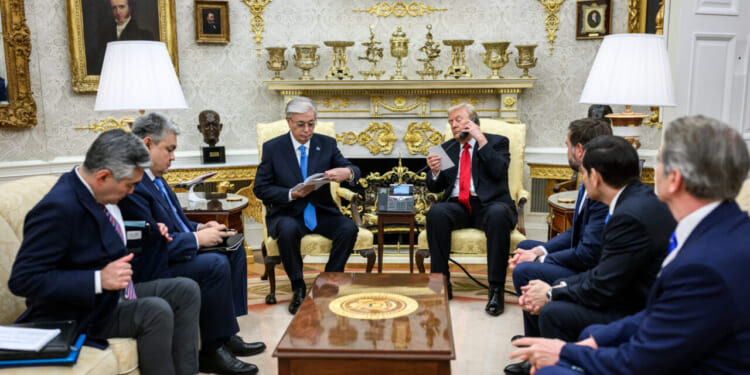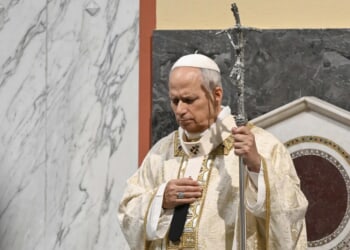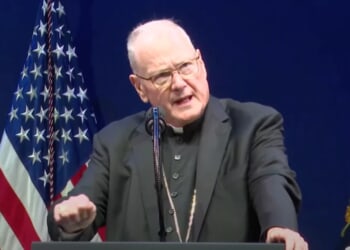In the last few months, the White House has delivered a number of policy victories that have strengthened the US position in the region.
In an atypical instance of substance with little fanfare, President Donald Trump launched a significant foreign policy initiative last week when he convened the presidents of the five Central Asian states in Washington to mark the tenth anniversary of the C5+1 Summit, a yearly meeting of the United States and the Central Asian nations. This group almost always meets in New York City in September on the margins of the United Nations General Assembly at the foreign minister level. Only once had the C5+1 met at the presidential level, and never in Washington.
Trump invited his Central Asian colleagues because his administration, as Deputy Secretary of State Christopher Landau announced at the Institute of World Politics gala in October, is seeking opportunities in regions that have not received sufficient attention from previous American policymakers. With this in mind, President Trump met with Uzbekistan’s president, Shavkat Mirziyoyev, in New York in September and dispatched Landau and Sergio Gor, US Ambassador to India and Special Envoy for Central and South Asia, to Kazakhstan and Uzbekistan in late October. All of this to explore opportunities in Central Asia because, as Paul Kapur, Assistant Secretary of State for South and Central Asia, said, “Under President Trump’s and Secretary Rubio’s leadership, we’re elevating the C5+1 partnership as a priority—a strategic priority and an economic priority.”
Business, Business and More Business in Central Asia
Most commentary on this initiative focuses on the economic possibilities for the United States in Central Asia. Since the fall of the Soviet Union and the independence of these states, the United States has been active in developing the vast hydrocarbon resources of the region. Chevron took the lead in exploring and extracting oil in Kazakhstan; the United States implemented the policy of multiple pipelines to bring landlocked Central Asia’s oil and gas to global markets.
Hydrocarbons remain part of the attraction for the United States, but equally—and possibly more important—are Central Asian rare earth and critical minerals. The United States has wasted decades in allowing China to take the lead in the mining and processing of especially rare earth minerals. China’s effective control over the supply chain of rare earth minerals gives it a major edge as the Trump administration seeks to achieve a fair trade relationship. Trump has taken on this challenge with characteristic energy, and Central Asia, particularly Kazakhstan, is rich in rare earth minerals. There are 28 reported deposits of rare earth minerals in the region, and Kazakhstan has reportedly identified at least tons of rare earth deposits.
In different engagements around the world, Trump has successfully brought in American business, and that was evident at the C5+1 Summit last week. The State Department presided over a C5+1 Business Conference at the Kennedy Center, where agreements on projects totaled over $100 billion, and prospective deals possibly reached multiples of that, according to the Commerce Department. Especially notable, given the growing importance of critical and rare earth minerals, was the deal signed by Cove Capital for the privatization of a tungsten company in Kazakhstan. However, the range of agreements also encompassed artificial intelligence and the sale of John Deere tractors and Boeing airplanes to several Central Asian states.
Getting Central Asian Goods to Global Markets
While the C5+1 summit focus was overwhelmingly on business and investment opportunities, it inevitably had a geoeconomic element, and this could be the most important outcome. The summiters endorsed the development of the Trans-Caspian Trade Route, an initiative that has been pushed for years by the Central Asian states as a means to access European markets. Here, too, Trump leveraged his success elsewhere in pursuing US interests in Central Asia.
On August 8, Trump convened the Presidents of Armenia and Azerbaijan to strengthen and stabilize their efforts to achieve peace. A key White House contribution was providing conditions for an agreement between the two countries on a transportation corridor from Azerbaijan through Armenia to the Azerbaijani enclave of Nakhchivan and then Turkey—known as the Trump Route for International Peace and Prosperity (TRIPP). As outlined in the Joint Statement of Intent on Economic Cooperation issued at the summit, the Caspian Trade Route will connect to TRIPP “to secure the movement of cargo, information, and energy for the benefit of the C5+1 countries and the world.”
The creation of this transportation corridor would, over time, reduce Russia and China’s economic hold on Central Asia. It would also build on the separate, successful efforts of Turkey and the United States to reduce Moscow’s role as the hegemon in the South Caucasus. Turkey did this by backing Azerbaijan’s victory in the war of 2020 and promoting peace efforts between Baku and Yerevan afterwards, which the Trump administration has enhanced. Together, if not in tandem, the United States and Turkey sharply reduced Moscow’s influence by ending its role as a “peacekeeper” that promoted tension, while trying to rein in hostilities between Armenia and Azerbaijan.
The Trans-Caspian and TRIPP corridors are set to enhance the relationship between Central Asia and the South Caucasus. This could lead to Azerbaijan joining the C5+1, a notion that it has quietly advanced and which the Central Asian states would support, though Washington has not taken on this particular point.
The Smaller Role of Geopolitics
Geopolitics did intrude on the summit last week. Kazakhstan’s President Kassym-Jomart Tokayev used the forum to announce that Kazakhstan was joining the Abraham Accords—Trump’s signature foreign policy achievement from his first term. While Kazakhstan has had diplomatic relations with Israel for over thirty years, this move still bolsters the accords and was a gesture to the Trump administration and its influence. Washington, too, offered a long-overdue gesture to its Central Asian partners as a bipartisan group in both chambers of Congress introduced legislation to remove Jackson-Vanik trade sanctions on the countries of Central Asia.
As for grand politics in the region once known for the Great Game, both the United States and the Central Asian states are cautious. The C5+1 summit did not take up major security questions, despite Central Asia’s unique geography, which is bordered by three major US adversaries: China, Russia, and Iran. The United States has strategic interests in preventing Russia or China from achieving decisive influence in the region. The Central Asian states, which have mostly managed to maintain stable intraregional tensions since independence, are establishing ever closer cooperation, in part as a hedge against their two large neighbors.
Central Asian governments are aware that there are nationalists in Moscow who would like, at a minimum, to regain control of northern Kazakhstan, where there is a sizeable ethnic Russian population and major hydrocarbon reserves. They also know that Chinese scholars and journalists have raised territorial claims against Tajikistan and Kazakhstan (and even Russia).
But for now, closer cooperation between the United States and Central Asian states on security issues is likely to be limited to terrorism, crime, and border control.
Fortunately, the Central Asians believe with good reason that greater attention from the Trump administration and a growing US business presence in the region strengthen their hand against their large neighbors. That certainly advances US strategic interests.
About the Author: John Herbst
Ambassador John Herbst is senior director of the Atlantic Council’s Eurasia Center and a former US ambassador to Ukraine and to Uzbekistan.
Image: White House / Public Domain.


















